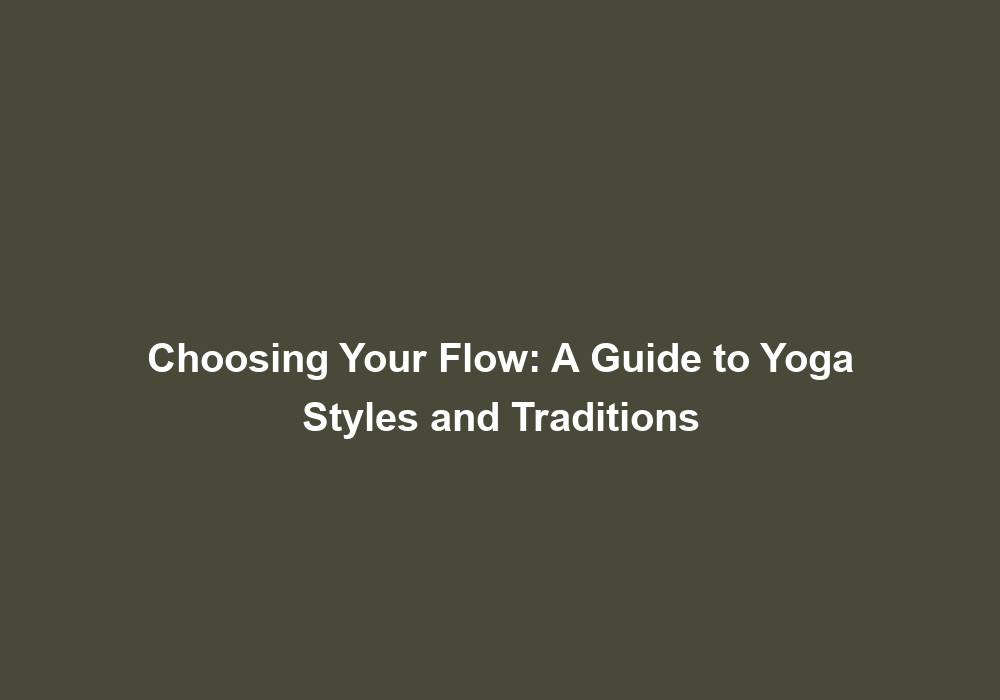Choosing Your Flow: A Guide to Yoga Styles and Traditions
Yoga has gained immense popularity worldwide, as it offers numerous physical, mental, and spiritual benefits. However, with the vast array of yoga styles and traditions available, it can be overwhelming for beginners or those looking to explore different options. This comprehensive guide aims to simplify the process and help you choose the ideal yoga style that aligns with your goals and preferences.
Understanding Yoga Styles
Yoga is not a one-size-fits-all practice. There are various styles and traditions, each with its own unique focus, techniques, and benefits. By familiarizing yourself with the different yoga styles, you can select the one that best suits your needs and resonates with your personality.
1. Hatha Yoga
Hatha Yoga serves as the foundation for most yoga styles. It places emphasis on physical postures (asanas) and breath control (pranayama). Hatha classes are generally gentle and slow-paced, making them an excellent choice for beginners. This style focuses on aligning the body, improving flexibility, and cultivating a balanced mind-body connection.
Some key points to consider about Hatha Yoga:
- It provides a solid introduction to yoga for beginners.
- The gentle pace allows for a deeper understanding of each pose.
- Hatha Yoga is suitable for individuals seeking to improve their flexibility and overall well-being.
- The focus on breath control helps in calming the mind and reducing stress.
2. Vinyasa Yoga
If you prefer a more dynamic and flowing practice, Vinyasa Yoga might be the ideal choice for you. Vinyasa classes are characterized by continuous movement, seamlessly transitioning from one pose to another in sync with the breath. This style is often referred to as flow yoga and offers a cardiovascular workout while enhancing strength, flexibility, and coordination.
Key features of Vinyasa Yoga include:
- It provides a more energetic and fast-paced yoga experience.
- The constant movement and synchronization of breath with movement create a meditative flow.
- Vinyasa Yoga is suitable for individuals who enjoy a challenging and varied practice.
- It helps in building strength, improving cardiovascular health, and increasing flexibility.
3. Ashtanga Yoga
Ashtanga Yoga follows a set sequence of poses, which are performed in a specific order. This physically demanding style incorporates synchronized breath (ujjayi) and internal energy locks (bandhas). Ashtanga classes are vigorous and structured, making it suitable for those seeking a more disciplined and intense practice.
Key aspects of Ashtanga Yoga to consider:
- It offers a structured practice with a set sequence of poses, providing consistency and discipline.
- Ashtanga Yoga is physically demanding and requires a certain level of strength and flexibility.
- The synchronization of breath and movement promotes focus and concentration.
- It is suitable for individuals seeking a challenging and intense yoga practice.
4. Iyengar Yoga
Iyengar Yoga places a strong emphasis on alignment and precision in each pose. Props such as blocks, straps, and blankets are commonly used to support the body and achieve optimal alignment. This style is great for individuals recovering from injuries or with physical limitations, as well as those who appreciate attention to detail and a slower-paced practice.
Key features of Iyengar Yoga include:
- It focuses on proper alignment, making it ideal for individuals with specific physical limitations or injuries.
- The use of props allows for a deeper understanding of each pose and helps in achieving correct alignment.
- Iyengar Yoga is suitable for individuals who prefer a slower-paced practice that emphasizes detail and precision.
- It helps in improving posture, increasing strength, and promoting body awareness.
5. Bikram Yoga
Bikram Yoga, also known as hot yoga, is performed in a heated room (typically around 105°F). This style follows a specific sequence of 26 poses and aims to detoxify the body through profuse sweating. Bikram Yoga can be physically demanding, so it’s important to stay hydrated and listen to your body’s limits.
Key points to consider about Bikram Yoga:
- The heated room helps in increasing flexibility, promoting detoxification, and preventing injuries.
- Bikram Yoga provides a challenging physical workout.
- It is important to stay well-hydrated and listen to your body’s signals in order to avoid overheating.
- Bikram Yoga is suitable for individuals who enjoy a challenging and intense practice in a heated environment.
6. Kundalini Yoga
Kundalini Yoga focuses on awakening the dormant spiritual energy within. It combines dynamic movements, breathwork, chanting, and meditation to achieve a deep sense of self-awareness. Kundalini classes often incorporate mantras and specific hand gestures (mudras) to channel energy and promote spiritual growth.
Key aspects of Kundalini Yoga to consider:
- It offers a holistic approach to yoga by combining physical movement, breathwork, and meditation.
- Kundalini Yoga focuses on expanding consciousness and promoting self-awareness.
- The use of mantras and mudras helps in channeling energy and connecting with a higher spiritual state.
- It is suitable for individuals seeking a spiritual practice that integrates movement, breath, and meditation.
7. Yin Yoga
Yin Yoga targets the deep connective tissues and joints, aiming to improve flexibility and promote relaxation. Poses are held for an extended period (usually 3-5 minutes) while focusing on breath and surrendering into the stretch. Yin Yoga is a gentle and meditative practice, ideal for balancing the fast pace of modern life.
Key points to consider about Yin Yoga:
- It provides a calming and meditative practice that complements a busy and stressful lifestyle.
- Yin Yoga targets the deep connective tissues, improving flexibility and joint mobility.
- The long-held poses allow for a deeper release and relaxation.
- It is suitable for individuals seeking a gentle and introspective practice that promotes relaxation and balance.
Factors to Consider
When choosing a yoga style, it’s important to consider various factors that align with your goals and preferences. Here are some aspects to keep in mind:
1. Physical Fitness Level
Different yoga styles require varying levels of physical fitness. If you’re a beginner or have limited mobility, starting with gentle styles like Hatha or Iyengar Yoga can be beneficial. For those seeking a more challenging and vigorous practice, Vinyasa or Ashtanga Yoga might be a better fit.
2. Goals and Intentions
Consider your goals and intentions for practicing yoga. Are you looking to increase flexibility, build strength, reduce stress, or enhance spiritual connection? Different styles emphasize various aspects, so choose one that aligns with what you hope to achieve.
3. Personal Preferences
Your personal preferences play a significant role in enjoying and committing to a yoga practice. Reflect on factors like class atmosphere, teacher style, and studio location. Some individuals thrive in a lively and energetic environment, while others prefer a calm and quiet atmosphere.
4. Lifestyle and Schedule
Consider your lifestyle and schedule when selecting a yoga style. Some styles, like Bikram Yoga, require a heated room, which may not be readily available in all areas. Additionally, take into account the time commitment and availability of classes that fit your schedule.
Conclusion
With the plethora of yoga styles available, selecting the right one can significantly enhance your yoga journey. Whether you prefer a gentle, alignment-focused practice like Iyengar Yoga or a dynamic, flowing experience like Vinyasa Yoga, there is a style that resonates with your needs and preferences. Experiment with different styles, listen to your body, and enjoy the transformative benefits that yoga offers.







